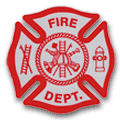

The eight-point Maltese Cross is the international symbol of the fire service's willingness to make great sacrifices in order to protect others from the ravages of fire. It is a badge of courage and honor and it's story is hundreds of years old.

This honored symbol originated with a group of eleventh century knights who were serving in a Jerusalem hospital during the 11th and 12th centuries. They became known as the Order of Knights Hospitaller and later became the Knights of St. John. A white or silver cross on a dark background was adopted by these Knights, as they were also known, because of their charity toward the sick and poor in setting up hospices and hospitals. This charitable organization cared for the ill with great compassion for hundreds of years. Their motto was "For the holy sick, our blessed Lord and for all, who continue the spiritual tradition of the Order of St. John at present in living deeds serving under the Maltese Cross".
The need for an identifiable emblem for the knights had become crucial during combat to protect and recapture Holy Land. Because of the extensive armor which covered their entire bodies and faces, the knights were unable to distinguish friend from foe in battle. They chose the cross of Calvary as their symbol since they fought their battles for a holy cause. The cross was later called the "Maltese Cross" and represented the principles of charity, loyalty, chivalry, gallantry, generosity to friend and foe, protection of the weak, and dexterity in service.
Later, they assisted the Knights of the Crusades (Knights Templar) through their goodwill and also through military assistance in an effort to win back the Holy Land against the Saracrens. As the Knights of St. John attacked the Saracrens, they encountered a new weapon unknown to European warriors. It was a simple, but a horrible device of war, it wrought excruciating pain and agonizing death upon the brave fighters for the cross. The Saracens weapon was fire. Greek Fire, to be specific. It was a gelatinous flammable liquid composed mostly of naphtha, sulfur and quicklime. The Saracens had learned about it the hard way 300 years before at the hands of the Byzantines. Constantine IV had used it against the Saracens in A.D.673 and again in A.D.718. The Crusaders had known of it, though not how to make it. The Saracens were particularly adept at delivering it. They used intricate and complicated engines of war, the exact design of which, like the formula for Greek Fire itself, has been lost.
For the next few years the Knights of St. John had no home territory. Eventually the Holy Roman Emperor Charles V granted the Knights of St. John the Island of Malta as a gift. On 26 October 1530 took possession of Malta, with the further approval of Pope Clement VII. It was at this time that the Knights of St. John undertook to remain neutral in wars between Christian nations. Defense of the Faith did not outshine service to the poor. The hospital of the Knights of St. John had about 2,000 beds, and there had also been a large hospital on Rhodes. The hospital of Malta, founded in 1532, continued the hospitaller tradition with accommodations for 500 patients who were served by the Knights themselves. The rule was the same as it had been for five centuries. The patients were served by the Knights before anyone else. They received the best meals - "white bread on silver plate".
As the Knights of St. John and Knights of the Crusades attacked the city walls, the Saracens first threw glass bombs containing highly flammable Greek Fire. On castle walls and the prows of ships, bronze tubes were employed that
emitted jets of liquid fire, to much the same effect as today's flame throwers. Glass bombs were filled with Greek Fire, and used much the same as today's Molitov Cocktail. Special arrows and spears were used, these being many times more effective when using other flammable materials. When the Knights of St. John became saturated with the highly flammable liquid, the Saracens hurled a flaming torch into their midst. Hundreds of the knights were burned alive; others risked their lives to save their brothers-in-arms from dying a painful and fiery death. Saracens also sailed their war vessels containing naphtha, rosin, sulphur, and flaming oil into the vessels of the Knights of St. John. Many knights were called to perform heroic deeds by rescuing fellow knights and extinguishing fires.
Thus, these men became our first firefighters. Firefighters wear the Maltese Cross to symbolize their willingness to risk their lives to save others from the ravages of fire. Today, the Maltese Cross still stands for the bravery and courage of firefighters that was demonstrated by the Knights of St. John hundreds of years before.
The symbol on their flag, the eight-point cross, then became known as the "Maltese Cross."
St. John's Wort?
Yes, this is the same Knights of St. John. This herb has long been prominent in folk medicine and, as its name suggests, was prized by the Knights of St. John. In some countries, including England, it was also used to decorate houses on St. John's Day. Recently, the Knights of St. John herb has increasingly begun attracting the attention of modern medical researchers. The appeal of alternative medicine is growing in Europe more rapidly than in the United States. In parts of Europe, St. John's Wort grows wild, and scientists have been studying it for decades. It is available in herb shops in liquid, capsules, and dried form. While St. John's Wort may not be well known in the United States, doctors in Germany prescribe it for depression and insurance pays for it. Some scientific studies published in the British Medical Journal suggest that St. John's Wort is as effective as any other conventional antidepressant and has very few side effects.
![]()